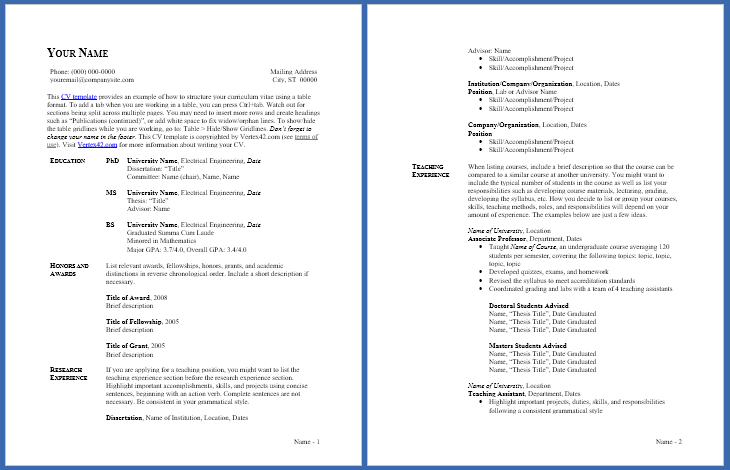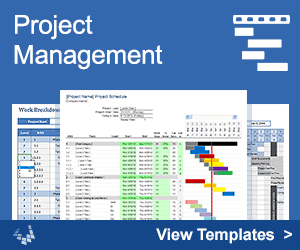CV Template (Curriculum Vitae)
A CV or Curriculum Vitae is a summary of a person's education, employment, publications, and other professional activities, awards, and honors. In the United States, a CV is used by people applying for a position in academia, research, or scientific field (as well as grants and fellowships). The Curriculum Vitae Template below was designed with this purpose in mind. Download the template and read through the suggestions below to learn how to write your CV.
If you are a graduate student, you should begin assembling your CV right away so that you have it ready to give to future employers. Use your CV to keep track of your accomplishments and publications so that it is always up-to-date.
In many other countries, a curriculum vitae is essentially the same thing as a resume. If that applies in your case, then check out our resume template.
CV Template - Outline Format
License: Limited Use (not for distribution or resale)
Description
Our CV Template includes many of the common categories in a curriculum vitae such as education, research experience, teaching experience, publications, awards, etc. Think of these sections as modules that you can move around or remove as needed.
The curriculum vitae template includes some instructions pertinent to various sections as well as sample publications and references.
This CV template was set up using Styles in Word. For example, to modify all the section headings, you can just modify the Heading 1 style. To change the font in the entire document, you can edit the Normal style.
CV Template - Table Format
License: Limited Use (not for distribution or resale)
Description
This version of the Curriculum Vitae is identical to the outline version, except that the document is structured using tables, with headings on the left.
Using the CV Template
Customizing: It will be very important for you to customize the template for your specific field, experience, and skills. The order of the various sections will depend upon what type of job you are applying for (such as teaching vs. research). See the reference below for examples of how to customize your CV.
Maintaining a Master Copy: You will probably end up with many different versions of your CV over time as you apply for different positions and grants. I prefer to maintain a single master CV template that contains the most up-to-date information.
Maintaining a Second Version: You may have information and categories in your master CV template that you do NOT want to include when you publish your CV or submit the CV to a potential employer. If you are in a hurry to send off an application, it is very easy to accidentally include a section in your CV that you didn't want to. So, you may want to consider maintaining a separate CV that you use specifically for submitting with applications.
Tracking Publications: If you are using your CV as a way to keep track of your publications, then it is useful to have a category for "Publications in Review". Unless you only have a few publications and would like to show that you have more in review, you may want to consider leaving out this section when you share your CV.
General CV Writing Tips
The 5 C's of Resume Writing - Convincing, Concise, Clear, Consistent, and Clean - also apply to curricula vitae. So, in addition to reading through our Resume Tips, here are some points to remember when writing a CV:
- Be Concise: A CV does not need to be a single page like a resume, but it still needs to be succinct. The length is proportional to your experience, number of publications, etc. Do not stuff your CV with everything you've ever done just to make it look longer.
- Check for Typos: Simple errors send a warning to the reader that you may do sloppy or careless work.
- Get it Reviewed: Get faculty members in your department to review your CV.
- Number the Pages: Include your name and the page number in the footer or header.
- Use a Simple Format: The format should make it easy for the reader to find the most important information. Use examples from your educational field as a guide.
- Use a Single Font: Times New Roman is a common font for a printed CV. Arial or Verdana is often used for online publication.
- Use bold, CAPITALS, and italics, but avoid underlining.
- Be Professional: If you include a personal email address, do not use a username like FunnyGuy12345@somewhere.com.
- Use full URLs: If you include links to online materials like articles, websites, or course descriptions, make sure the give the full URL.
- For more guidelines and tips, read the references listed below.
How to Find More CV Examples
A great place to find CV examples is to go to your favorite university's web page and find the faculty page for your department. For example, if you are a mechanical engineer, look for faculty in ME. Many faculty members will publish their CV online (minus some personal details and references).
You can also try a Google search like "CV Example site:.edu filetype:pdf"
References and Resources for Writing a CV
- [1] Resumes vs. CV's: when do you use which? - career.virginia.edu
- [2] CV Writing at career.berkeley.edu - An excellent 2-part article.
- [3] Resumes and CVs at careers.unc.edu
- [4] Writing the Curriculum Vitae at owl.english.purdue.edu


